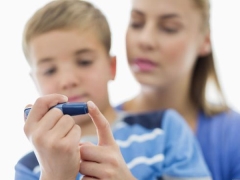Diabetes in children
The development of diabetes in children most often occurs rapidly, so it is important to identify the disease in time and begin its treatment. Why do babies have diabetes, how does this pathology manifest and can such a disease be cured?
Causes
The exact reasons why children develop type 1 diabetes are not yet known. The child’s immune system begins to attack the pancreas, destroying the cells responsible for insulin production.
The appearance of this type of diabetes in a child can be triggered by an infection of viral genesis or significant nervous shock.
Disease progression
The disease begins with the defeat of beta cells, which are part of the pancreas. They are destroyed by the immune system of the child, which leads to a violation of their function, which is the synthesis of insulin. This hormone is involved in metabolic processes and is very important for carbohydrate metabolism.
Insulin acts as a key that unlocks the cells, letting glucose into them, which serves as an energy substrate for them. As soon as glucose enters the cells, its level in the bloodstream decreases, which becomes a signal to reduce insulin secretion, and at the same time prevents too much sugar levels from falling.
In the exchange of insulin and glucose there is a constant feedback. As soon as there are more glucose in the bloodstream, the insulin level increases at the same time, and vice versa.
In diabetes, insulin production decreases, which leads to constantly elevated blood sugar levels. In this case, the cells also suffer, because they receive less glucose.
Transmission of the disease by heredity
A child may inherit a tendency to develop diabetes, but this does not mean that he will become ill, even if close relatives suffer from diabetes.
Who is most likely to get diabetes?
Risks of development of this pathology increase if:
- In the family of the baby there are patients with diabetes.
- The child has problems with metabolism.
- Weight at birth was more than 4500 grams.
- The baby has lowered immunity.
Type 2 diabetes are at risk for children who have obesity and other metabolic disorders.
Symptoms and signs
A feature of diabetes in childhood is the rapid development of ketoacidosis, since the enzyme systems in the child’s body are still immature, and toxic products are eliminated slowly.
Within a few weeks after the first symptoms of diabetes in a child, diabetic coma may appear. That is why early detection of diabetes and timely treatment is so important.
You may suspect diabetes in a baby if:
- The child often suffers from thirst, and especially to ask to drink in the evening.
- The child has an increased appetite. It is difficult for him to endure long breaks between meals.
- Baby dramatically thin.
- He has frequent urination, and the child often goes to the toilet at night.
- After eating, the condition may worsen.
- The child may also have increased sweating and lethargy.
- A child often has relapses of infection, for example, candidiasis, boils, infectious skin lesions.
In infants who have difficulty in detecting increased thirst and frequent urination, poor weight gain, restless behavior, and the appearance of diaper rash can lead to the thought of diabetes. The urine of children with diabetes can leave sticky stains on the floor and starch stains on diapers.
Severe symptoms in which the child should be given immediate medical attention in case of diabetes are:
- Frequent episodes of vomiting.
- Dehydration.
- Great weight loss.
- Rare breathing, in which the child takes a noisy deep breath, followed by a forced exhalation.
- The child is sluggish, disoriented in space, may lose consciousness.
- Pulse accelerated.
- Acetone odor may be released from the mouth.
Types
Most often in childhood type 1 diabetes. However, in recent years, the identification of type 2 disease in children over ten years of age has become more frequent.
Both types of diabetes are characterized by severe thirst and over-consumption of food, as well as polyuria. In this case, the first type of diabetes has the following characteristics:
- The disease can begin at any age, even in infants.
- A patient can have any body weight.
- Hypertension, dyslipidemia in the blood, fungal infection of the vagina in girls and dark spots on the skin, called acanthosis nigricans, are very rare.
- Antibodies to the pancreas are detected in the blood.
The second type has the following distinctive features:
- The disease in childhood often begins in adolescents in the puberty phase.
- The patient is usually obese.
- The disease is accompanied by an increase in blood pressure, the appearance of spots of acanthosis nigricans, thrush in girls and changes in the indicators of fat metabolism in the blood.
- Autoantibodies to the pancreas are not detected.
Diagnostics
Suspecting diabetes in a child, he is prescribed tests that either confirm the diagnosis or rule out this pathology in a baby. Also, the diagnosis of diabetes is aimed at clarifying the type of disease, its stage and methods of treatment.
The first analysis, which is assigned to the child - blood glucose test. The sample must be given on an empty stomach and in the case of an elevated index it is repeated and also with a load.
To clarify the type of diabetes, donate blood to detect antibodies to pancreatic cells, enzymes and insulin. The presence of antibodies confirms the diagnosis of type 1 diabetes.
Is it possible to cure?
A complete cure of diabetes in a child is impossible to achieve, but with the right approach to nutrition and drug therapy, you can achieve a long-term remission, which is called "honeymoon." During remission, the child's condition improves significantly and daily insulin administration is not required.
What is the treatment?
Therapy of children with diabetes is aimed at ensuring the normal development and growth, as well as the prevention of severe complications of the disease. The child is prescribed a low carbohydrate diet. In the first type of diabetes, insulin injections are shown, in the second, certain groups of drugs in pills are shown.
Blood sugar control
To keep diabetes in a child under control, blood glucose levels should be measured regularly, so buying a glucometer is one of the primary tasks. The sugar level will have to be measured daily four or more times a day. It is important to check the accuracy of the meter, because it affects the treatment.Saving on this device and test strips to it threatens to treat the complications of the disease in the future.
There are devices that monitor glucose levels all day. They are worn on the belt, and after the needle inserted into the body the glucose is measured after a certain period of time. It should be noted that these devices have a rather large error and the usual blood glucose meter is more accurate indicators.
All measurements (their time and data obtained), as well as other circumstances (insulin administration, food intake, diseases, exercise, stress, etc.) should be recorded in a diary. This will help in monitoring the condition of the child and treatment.
Insulin administration
If a child has type 1 diabetes, insulin shots are a vital necessity for him. The use of the hormone through the mouth is impossible, since it will be destroyed by enzymes of the stomach. So injections are the only option to deliver insulin to the bloodstream.
There are types of insulin, which have a very fast action, but after a few hours it stops. There are other species whose effects are smoother and longer.
The hormone is injected with special syringes, which have a thin needle. Also designed syringe pens, similar to conventional pens, but not containing ink, and insulin. There are also devices called insulin pumps. They are put on the belt, and a needle is inserted into the skin of the abdomen and fastened. Such a pump is programmed to supply the hormone in small doses throughout the day.
Is life possible without insulin?
This question interests all parents in identifying the first type of diabetes in their child. On their desire to avoid hormone injections, charlatans and fraudsters make money. In fact, drugs and procedures that could relieve a person with type 1 diabetes from insulin injections do not yet exist.
Using low carbohydrate nutrition can only reduce the need for insulin and achieve a long “honeymoon” - a period when the level of glucose in the blood decreases and treatment is not required.
Diet and nutrition
Thanks to a diet with a low amount of carbohydrates in children who have recently been diagnosed with the disease, a long "honeymoon" begins. The period without jumps in sugar levels stretches for months and even years. In children who have been ill with diabetes for a long time, such a diet can reduce the required doses of insulin several times and stabilize blood sugar.
Features of nutrition of a child with diabetes:
- Preference is given to protein foods and foods with natural fats. The basis of the diet should be poultry, fish, eggs, cheeses, seafood, meat, butter, green vegetables, mushrooms.
- Foods with carbohydrates should be consumed in small doses, distributing them evenly throughout the day.
- High carbohydrate foods (sugar, bread, cereals, potatoes, fruits, juices, etc.) should be excluded.
- There is a need only with the feeling of hunger. In this case, the child should not starve, otherwise there is a high risk of disruption.
- Overeating should be avoided, even if foods are allowed for diabetes.
- It is advisable to plan the menu and do not deviate from this plan.
- You need to carefully study the labels of products to determine the percentage of carbohydrates and hidden sugar.
- Not recommended products marked "fat free" and "diet." In many of them, fats are replaced by carbohydrates.
- All new foods need to be tested by checking blood glucose 15 minutes and 2 hours after eating.
- The use of vitamin and mineral supplements is desirable.
Kindergarten and school
Attending kindergarten and school can be a problem for children with diabetes and parents.Educators and teachers are usually poorly informed about diabetes and cannot feel the problem, but they are also responsible for the health and life of the child while he is in the educational institution. Parents will have to talk a lot and explain all the nuances of the child’s illness - director, class teacher, teachers (especially the physical education teacher). Further, the situation should always be under their control.
A lot of difficulties are caused by feeding a child in the canteen and administering insulin before eating. The garden or school staff should be informed about what food is prohibited for the child. You also need to decide where the child will be prickled before eating insulin - in the classroom, in the medical room, in another place.
Be sure to discuss with the child his actions in the case of different unplanned situations in the school. For example, what to do if the classroom is closed and the food is left in the briefcase, or if the medical office suddenly turned out to be closed or the nurse went away. A child should know what to do if, for example, he has lost his keys or is stuck in an elevator.
A child attending school should gradually be taught how to care for themselves. He must understand what food is contraindicated to him, as well as how to act in case of hypoglycemia. A child should always have with him quickly digested sources of carbohydrates. Conflicts with classmates can also be a problem, since hypoglycemia can occur during stress.
Sports activities
Physical activity is very important for children with diabetes, especially when it comes to the second type. The child can be given to the sports section and dancing. But even with type 1, physical education brings many benefits to children and increases their quality of life. It is important not to forget that physical activity affects the level of glucose, lowering it within 12-36 hours after exercise.
With a sharp physical activity, sugar, by contrast, may increase. If a child with type 1 diabetes is involved in sports, he or she will have to use a glucometer more often.
Possible complications
The disease can be complicated both by acute conditions requiring immediate treatment (hypoglycemia, as well as ketoacidosis), and by chronic changes in the internal organs.
With frequent jumps in the level of glucose in a child can develop:
- Disorders of the heart.
- Vascular pathology.
- Neuropathy.
- Kidney damage.
- Retinopathy caused by impaired blood supply to the eyes.
- Deterioration of the skin - peeling, itching, increased risk of infection.
- Limb problems associated with impaired blood flow in the legs and problems with nerves.
To prevent such complications helps control blood glucose levels. In addition, it is important to regularly visit an ophthalmologist and take urine and blood tests to identify complications in the early stages.
Tips for parents
- When identifying type 1 diabetes in a baby, you will need to study a large amount of information about administering insulin to a child. On the existing types of hormone, the calculation of the optimal dose and other nuances. It is extremely important for the life of your child.
- Also, parents should know how acute complications of the disease appear, What kind of diet is suitable for their child, when hospitalization may be needed.
- Try to keep the child active, for example, doing physical exercises with him.
- You will need to build relationships with caregivers and teachers, so that the child can attend childcare facilities on an equal basis with others.
- If a child is on a low carb diet, You should not give him undiluted insulin from a syringe pen, since even one unit of the hormone can be too much.
- Do not immediately grab new items in the field of diabetes care, as soon as they are released to the market. Do not test new insulins, measuring devices, drugs and other innovations for your child.Wait at least two or three years to know for sure about all their advantages and nuances.
- Encourage your child to look for classes of interest and develop his abilities. Do not forbid him to go on excursions, clubs, sports sections. Just think of a plan for each situation, how to act in case of hypoglycemia.
Be especially careful when the child approaches adolescence. During this period, you may experience psychological problems associated with the disease. A child may begin to eat prohibited foods secretly or in a company so as not to stand out among friends. Situations in which a child revolts against insulin shots and a low-carb diet are very dangerous for his health. Try to explain to him the consequences and outcome of such behavior.
When are children given a disability?
If a child has diabetes of the first type, which requires insulin treatment, then up to 14 years of age, the child with disability is assigned a group-free disability. At age 14, a further decision is made regarding the determination of disability based on the course of the disease and the presence of complications.
Prevention
If a child has a genetic predisposition for type 1 diabetes, a low-carb diet helps prevent damage to the pancreatic cells responsible for insulin synthesis.
You should also carefully enter the supplements, as too early feeding with cereals and cow's milk are among the risk factors for the development of the disease.















